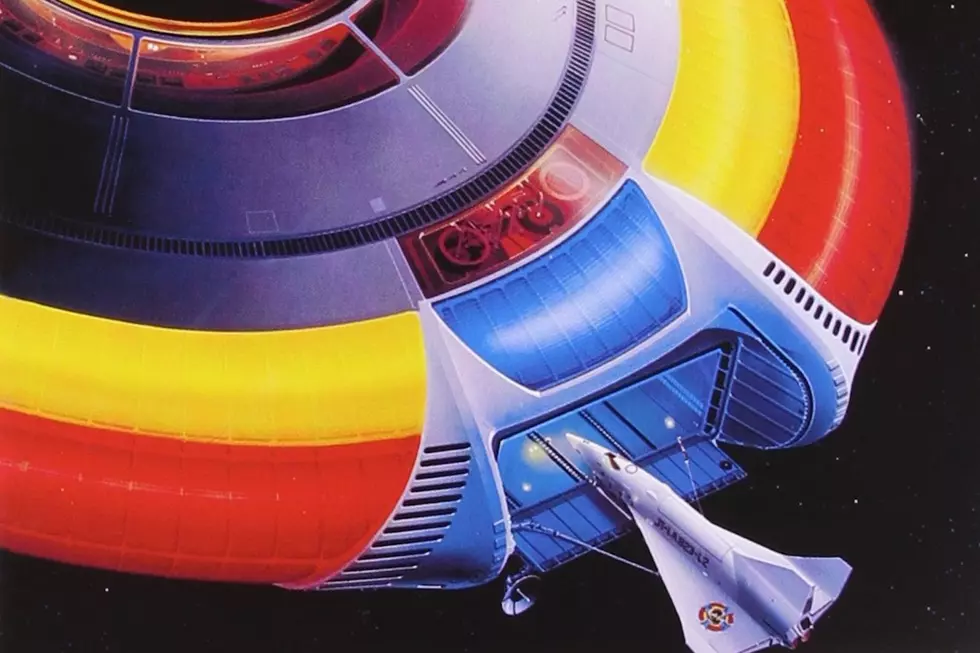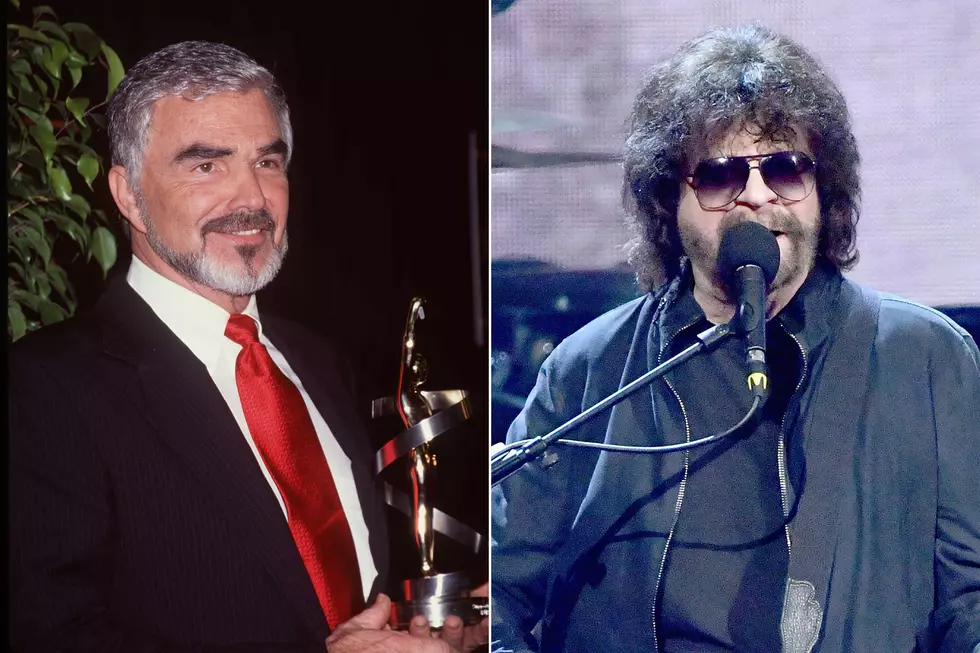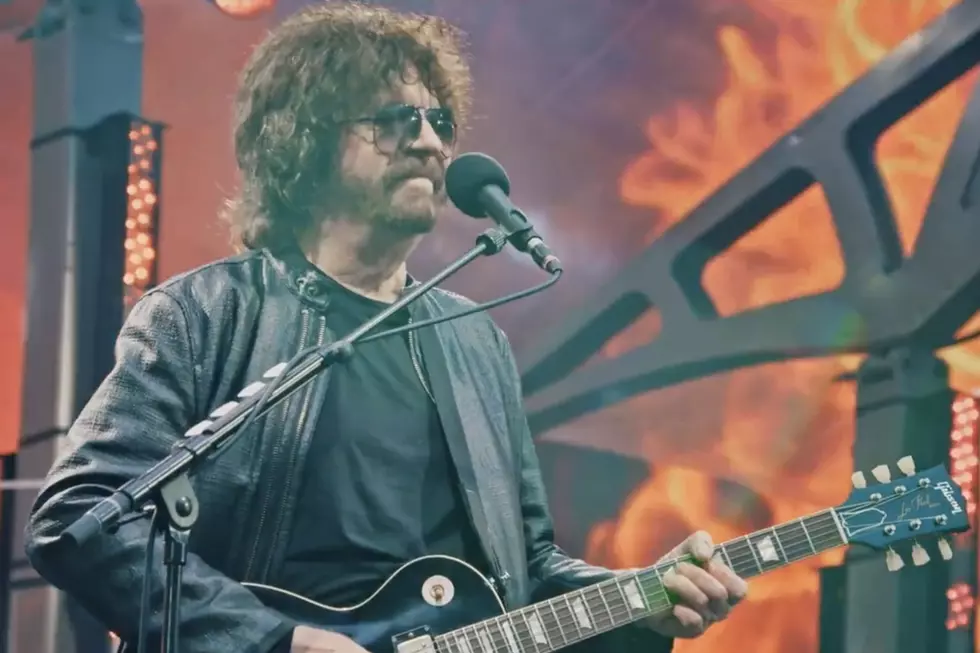
Why ELO’s ‘Out of the Blue’ Marked a Turning Point
With Out of the Blue, everything got more expansive for the Electric Light Orchestra – the songs, the concept, the shows and the issues.
The October 1977 follow-up to their first-ever platinum release would balloon into a double album, with a tour that found ELO emerging from a full-sized spaceship like the one featured on the cover. The music shared the same maximalist viewpoint, as mastermind Jeff Lynne threw himself into creating something better – well, certainly bigger – than 1976's A New World Record.
Oddly enough, its beginnings were decidedly small-scale: Lynne composed Out of the Blue in a remote chalet in the Swiss alps, where – after an early struggle with writer's block – everyday life tended to spark sweeping new creative ideas. "It was a time of total music for me," Lynne said in Electric Light Orchestra: Before and After, "and once I got rolling, the songs just kept on coming."
Initially, a gloomy dampness descended near Lake Geneva, and Lynne struggled to create the album. When the sun finally returned, so did his muse – and "Mr. Blue Sky" was born. "I suppose this is my most well-known song," Lynne told Rolling Stone in 2016. "I remember writing the words down. I was at a chalet in the mountains of Switzerland and it was all misty and cloudy all the way around. I didn't see any countryside for the first four days or so, and then everything cleared and there was this enormous view forever and the sky was blue."
"Starlight" was likewise celestially inspired, this time by the nighttime canopy over the mountains. Rain storms broke up a friendly game of soccer outside Munich's Musicland Studios where ELO were recording Out of the Blue; that sparked the rest of "Concerto for a Rainy Day," which took up all of the Side Three.
He eventually emerged with something sonically similar to its predecessor, but Out of the Blue doesn't have the same tightly wound construction. Its high points – the hits "Turn to Stone" and "Sweet Talkin' Woman," in particular – were dizzyingly high, but its excesses were so emblematic of an indulgent era as to be definitive.
"'Turn to Stone' is one of my favorites I ever did. It's just so primary and simple, but yet very evocative," Lynne told Rolling Stone. "There's a part in the middle where I talk super fast. I just felt like it needed something simple in the middle of the song. I often used to put a funny little piece in a song, just in case I get bored with it. I'd go, 'Well, maybe this is going on too long. I'll think of something daft to put in there.'"
Watch Electric Light Orchestra Perform 'Mr. Blue Sky'
Unfortunately, this tendency toward overthinking could end up becoming too cute by at least half. The only-in-the-'70s "Concerto for a Rainy Day," for instance, included a staccato burst of strings that actually spelled out Morse code for "ELO." (Just when you think this 19-minute, four-song ride might be over, Lynne exclaims, "Here it comes again!" on the terrific "Summer and Lightning.") Ultimately, Out of the Blue loses considerable steam through the too art-rockish "The Whale," before stalling out completely for a spaghetti-western side road called "Wild West Hero."
Whatever their relative value to the project, these moments actually balanced out a growing worry from co-founding drummer Bev Bevan. ELO were emerging as something of a hit-song factory – the million-selling Out of the Blue matched A New World Record by again producing three Top 40 songs – and he became concerned that commerce might be overtaking the art. The mammoth resulting tour only exacerbated things.
"We tended to look at the charts a lot," Bevan told the Moscow Times in 1994. "That's the trouble, you get success and you want more. When we first started making albums, we never thought about what song is going to be a single. But by the Out of the Blue album, certainly we'd make an album and think, 'Which of these tracks are going to be singles, and let's make them the right length, and let's mix it so it's good for radio.'"
Even as this became their highest-charting U.S. album, Electric Light Orchestra set out for a set of worldwide dates between February and October 1978 that confirmed their new superstar status. They filled huge venues like Wembley, the Pontiac Silverdome, Philadelphia's Spectrum and Madison Square Garden, appearing in a wildly embellished setting that echoed Out of the Blue's out-sized themes.
Each night, ELO took the stage to the musical accompaniment of Benjamin Britten's Sinfonia da Requiem performed by the London Symphony Orchestra. "The stage was basically a space ship, like a flying saucer," Bevan said in the 2012 documentary How the Brits Rocked America. "There's all of this dry ice, and lasers flashing – and then it would open, very, very slowly, and the band would come up on risers onto the stage. It was a spectacular opening to a show." ELO would remain there, inside the flying saucer's confining circle, until they departed – again to the accompaniment of Sinfonia da Requiem. Lynne, who admittedly enjoyed creating the albums more than performing them, was becoming increasingly uncomfortable with it all.
"I was reluctant to become a real rock star," he told Rolling Stone. "My favorite thing in the world was to work 14 hours a day in the studio. Everything else was peripheral to me, like having the record out and promoting it. ... I was a songwriter, singer and producer. Rock stars are different."
Listen to Electric Light Orchestra Perform 'Sweet Talkin' Woman'
In truth, the sheer spectacle of this period had begun to wear on the entire group, even as Lynne continued to play a more central role in everything they did.
"By that time, the stage production was so big that you didn't actually see the audience," Kelly Groucutt, the band's late former bassist and backup singer, told Martin Kinch in 1996. "They were so far away with that huge spaceship set that we had. That was sort of 50 feet across, and miles away from the audience. So, it was quite enjoyable to be thrust at that height, because it was probably about the biggest production on the road that was going on at that time – and everyone was impressed with it. But it was a pain in the butt, actually, to work in that spaceship."
As the tour continued, controversy loomed when a lawsuit by a disgruntled promoter revealed that ELO were selectively using taped material to replicate the densely arranged new songs. ("Anyone who knows anything," an ELO spokesman fired back, "knows that a lot of groups use tapes as part of their show.") There were other complications. The final two stops with the spaceship set, both in Montreal, were called off because of a disagreement over taxes with the government.
Electric Light Orchestra would never again attempt something so ambitious, either on the road or in the studio. Out of the Blue serves as both a pinnacle, and a turning point.
"I hated it when we were playing arenas," Lynne told the Los Angeles Times in 2015. "You wake up at 9 o'clock, have a horrible hot dog at the airport for breakfast, then do three flights to get where you're going. As soon as I was able to stop, I said, 'That's it.'"
The group already seemed to be winnowing around Lynne's vision. He dominated Out of the Blue as songwriter, producer, arranger, singer and guitarist. But now violinist Mik Kaminski was being used only sparingly, Melvyn Gale appeared on piano rather than cello for "Wild West Hero" and fellow cellist Hugh McDowell was nowhere to be found.
By the time Electric Light Orchestra returned with 1979's Discovery, Gale, Kaminsky and McDowell were gone. Secret Messages, released in 1983, marked the last album featuring the foursome of Bevan, Lynne, Groucutt and keyboardist Richard Tandy. Lynne became the lone Out of the Blue-era member featured on ELO's modern-era recordings, including 2001's Zoom (though Tandy guests on one track), 2012's Mr. Blue Sky (a set of re-recorded hits), 2015's Alone in the Universe and 2019's From Out of Nowhere (which also features a single song appearance from Tandy).
See ELO Among Rock’s Most Underrated Albums
More From 100.7 KOOL FM










